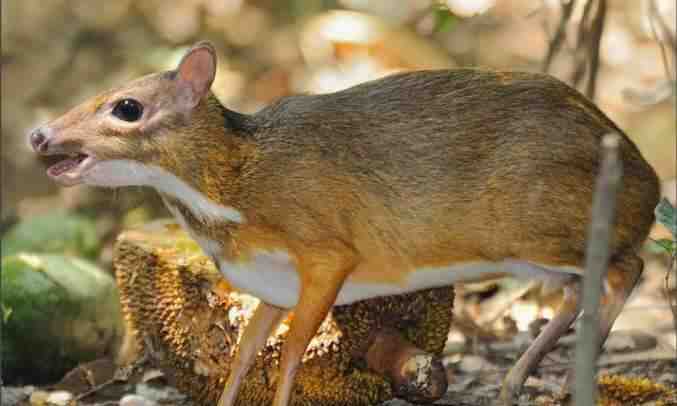Wilbur's mouse deer
IUCN
LCBasic Information
Scientific classification
- name:Wilbur's mouse deer
- Scientific Name:Tragulus williamsoni
- Outline:Ungulata
- Family:Artiodactyla Tragulidae Tragulus
Vital signs
- length:47cm
- Weight:1.3-2kg
- lifetime:No verification yet
Feature
A very small primitive deer
Distribution and Habitat
The chevrotain is mainly distributed in northern Thailand and Laos. It is the only chevrotain species in China, only found in Mengla County in southern Yunnan. The survey results from 2015-2016 further expanded the geographical northern limit of the species distribution of the chevrotain to the north, indicating that the species is more widely distributed in Xishuangbanna and even in China than previously known. The high-altitude upper reaches of the Nanla River in the China-Laos cross-border area in the northeast of Mengla County may be an important habitat for the chevrotain.
The chevrotain mainly inhabits tropical savannas, shrubs and broad-leaved forests. It likes to move in tropical secondary forests, shrubs, grass slopes and other areas, and sometimes enters farmland. From 2015 to 2016, scholars from Beijing Normal University conducted a wildlife resource survey in the China-Laos cross-border area in the northeast of Mengla County, Xishuangbanna, and found that the chevrotain
Appearance
The forelimbs are short, the hind limbs are long, and the tail is short, suitable for jumping. The face is pointed and long. The forehead is hornless. Males have well-developed upper canine teeth that appear like fangs exposed outside their lips. The upper body and sides of the body are muntjac yellow, with significant white stripes on the lower side of the neck, and the chest and abdomen are light brown.
They mainly feed on plant leaves and stems, with young leaves, stems and berries as their staple food, and grass as their non-staple food.
Details
Williamson's Chevrotain, also known as Williamson's Chevrotain in English, is a very small primitive deer species with no subspecies.

The Wilhelm's mouse deer is a species of mouse deer distributed in northern Thailand and Laos and Mengla County, Yunnan Province, China. It was originally classified as the lesser mouse deer (Tragulus javanicus) together with the Java mouse deer (Tragulus javanicus). kanchil), and the Javan mouse deer and Williamson's mouse deer have become independent species since 2004. In 1916, a man named "Williamson" described the "Yunnan mouse deer" based on skulls and other materials excavated in "Phrae" in northern Thailand, so the Yunnan mouse deer is also called "Williamson's mouse deer", and its scientific name "Tragulus williamsoni" carries Williamson's name.
Williamson's mouse deer is a nocturnal animal, mainly foraging in the early morning and dusk, often moving and foraging near water plants by the stream in the early morning and dusk. It is originally small in size, and unlike deer, it does not have developed and hard horns for self-defense. Its fighting power is basically "negative", so it is timid and alert by nature, relying on hiding in the forest and agile movements to avoid danger-it can jump and run like a rabbit, and can also swim and escape when frightened. Generally active alone. It likes water and is good at hiding. It has a keen sense of hearing and smell.
The chevrotain can breed all year round, with a gestation period of 4-6 months, one cub per litter (occasionally two cubs), and can continue to estrus soon after giving birth, and can even be pregnant while breastfeeding. The cubs can stand and move soon after birth, and reach sexual maturity in about 5 months.
Due to some taxonomic uncertainties and lack of data on occurrence range, threats, habitat preferences and altitude range, it is impossible to assess the status of the chevrotain. The lack of data on the chevrotain population in the high mountains of Thailand, China and northern Indochina prevents speculation on the extent of occurrence and thus prevents the application of the Red List criteria. Although hunting is heavily prevalent throughout the species' likely range, and habitat disturbance there is increasing, the lack of knowledge of the impacts of population levels on the species precludes the application of inferences based on the criteria for decline. Despite no records since 1916, there seems to be no reason to consider it a candidate for possible extinction, as the lack of records is thought to reflect the lack of suitable surveys. The species is therefore confirmed as data deficient. But even the small amount of current information allows the species to be classified and may warrant one of the Near Threatened or Threatened categories.
Listed in the IUCN Red List of Threatened Species 2014 ver3.1 - Data Deficient (DD).
Protect wildlife and eliminate bushmeat.
Maintaining ecological balance is everyone's responsibility!








